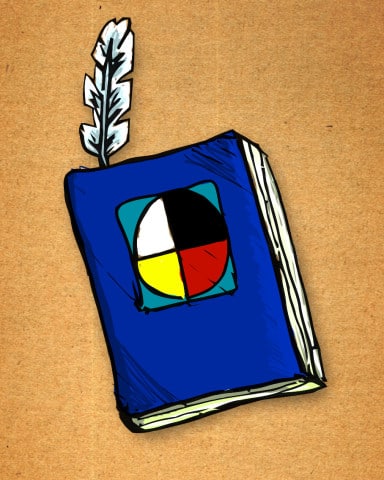MICHELLE WHITSTONE
Aboriginal fiction is rich and varied, and students at the University of Saskatchewan can take advantage of an extensive collection of work by Canadian authors housed in the Education Library Aboriginal Education Collection. The following are works of poetry and fiction that will help you experience Aboriginal perspectives through beautiful stories and voices.
Two spirits dancing on the cover lead the reader on an autumn nature hike through the pages of Last Leaf First Snowflake to Fall, written and illustrated by award winning author Leo Yerxa. Born in 1947 on the Little Eagle Reserve in northern Ontario, Yerxa shares his stories of home, using grandiose language to depict the oneness he felt with nature while wandering the hunting forests with his father as a child.
Yerxa’s unique style can be experienced the second you open the book and begin the adventure.
“I touched that frost on the window with my nose / The frost melted away, forming a tiny hole / I pressed my eye to the hole and looked to the sky / My eye walked in darkness, from star to star / The  first light found its way through the forest / Through the frosted window and across my face / A new day began,” reads an excerpt from Yerxa’s prose-poem.
first light found its way through the forest / Through the frosted window and across my face / A new day began,” reads an excerpt from Yerxa’s prose-poem.
Another author that reflects on themes of childhood is David Bouchard. With the help of Allen Sapp of Red Pheasant First Nation and music from Northern Cree, a renowned drum group from Hobbema, Alta., Bouchard created Nokum is my teacher.
Questions from a young boy to his grandmother illustrate his struggle with adopting a foreign culture and mindset.
Bouchard wrote: “Answer this then please, Grandmother, / Why must I go to their school? / I am told to sit and listen, / I’m supposed to somehow care / About their towns and their big cities, / Their fast cars and pretty things. / If they ever stopped to ask me / I’d prefer to drum and sing.”
Elaine J. Wagner’s Meshom and The Little One subtly describes a young girl’s loneliness for home. Meshom — which means grandfather — gifts Wagner an unpainted plaster figurine as she readies to leave her home in Manitoba for a city on the West Coast with her mother. Meshom tells her about “The Little Ones,” Ojibwa tricksters, who are always meddling and making mischief. Meshom and Kokum — which means grandmother — play a quiet key role as the heart of the story and help their granddaughter accept her new home and her new surroundings. Wagner ties in the importance of her native language, which needs to be spoken if it’s to be saved.
The Gathering Tree by Larry Loyie of Slave Lake and Constance Brissenden portrays an 11 year-old boy and his younger sister who come to realize their favorite cousin is HIV positive. The book involves a gathering of their people at an old tree where important conversations take place and truth is laid bare. It is only then that healing truly begins. Their story ties in the traditions of tobacco and the tying of ribbons on a tree and encourages self-motivation and strength through the tradition of foot racing. The young boy becomes a man and realizes true strength comes from within.
Aboriginal teachings are captured between the pages of these gifted authors and they inspire enlightened realizations. These books are calling out to be shared by those who wish to bring important issues to light and gain a better sense of self. Read an Aboriginal fiction book or share one with those you love and learn about their wonderful traditions of healing.
These works share in common the theme that Aboriginal people are attempting to overcome an adverse world and still question the transition process that could provide connections which can bridge cultures. Aboriginal fiction offers valuable, multi-faceted perspectives and a transferring of age-old wisdom for readers from all walks of life. There is much healing and understanding yet to happen and there are a wealth of realizations that can be shared through pages white and letters black.
—
Graphics: Jeremy Britz/Graphics Editor